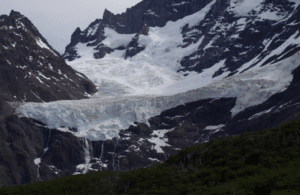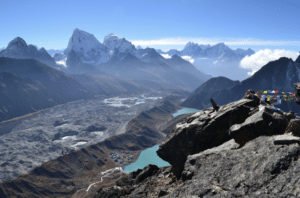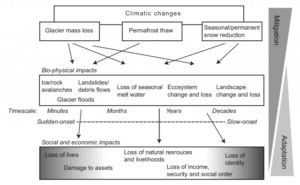
Written by Andrew Angle. This article was first published on GlacierHub.
Few areas of the planet have been more affected by climate change than the mountain cryosphere, where negative impacts like glacier recession far exceed any positives like short-term increases in glacial runoff. These adverse changes make highland environments ideal for examining the policy concept of Loss and Damage (L&D), which deals with the impact of climate change on resources and livelihoods that cannot be offset by adaptation. A recent study in Regional Environmental Change analyzes L&D in the mountain cryosphere by extracting examples from existing literature on the subject and developing a conceptual approach to support future research to address the subject.
L&D has become an important issue within the international climate policy realm in recent years. In the mountain cryosphere, the effects of climate change and the resultant L&D are directly evident. However, despite the visibility of these changes, research on L&D has rarely focused on these mountain environments, says the study’s lead author (and Mountain Research Initiative Co-PI and SLC Member) Christian Huggel, who spoke with GlacierHub about his paper.
The Francis glacier in the Chilean Andes. The Andes had the most papers examined by the study (Source: Pieter Edelman/Creative Commons).
The dearth of research presented a unique opportunity for Huggel and his team to analyze L&D in the mountain cryosphere, to provide information to policymakers, and to create a framework for future research.
L&D work within the United Nations Framework Convention on Climate Change (UNFCCC) first emerged around the impacts of sea-level rise on Small Island Developing States in the early 1990s, gaining further traction at the UNFCCC’s COP19 in Warsaw, where the Warsaw Mechanism for Loss and Damage associated with Climate Change Impacts was established. Then in 2015, at the landmark COP21 in Paris, the Paris Agreement’s Article 8 was dedicated to L&D. Although this article acknowledges the importance of L&D, it also states that it “does not involve or provide a basis for any liability or compensation,” which is a serious limit to concrete action.
Despite the attention to L&D in international climate negotiations, significant controversy still surrounds the issue. Most of this controversy centers on the historical responsibility and potential liability of the developed countries for climate change impacts, with developing countries arguing for compensation, risk management, and insurance from the developed world.
Huggel told GlacierHub, “As the first systematic study of L&D in the Mountain Cryosphere, the researchers had to first frame existing literature on mountain climate change impacts within the concept of L&D.” To do this, they considered peer-reviewed literature published in English between 2013 and 2017 that dealt with issues of glaciers and climate change, and more specifically glacial shrinkage and permafrost degradation. Their search procured 41 papers for the final analysis.
 The Ngozumpa glacier in the Himalayas. The Himalayas had the second highest number of papers examined by the study (Source: Sebastian Preußer/Creative Commons).
The Ngozumpa glacier in the Himalayas. The Himalayas had the second highest number of papers examined by the study (Source: Sebastian Preußer/Creative Commons).
They next considered the geographic distribution of these papers. Surprisingly, the majority of papers focused on the Andes and the Himalayas, while fewer focused on Europe and North America, despite better documentation of climate change effects in those regions. Overall, none of the papers explicitly mentioned L&D while highlighting glacial and climate change processes. Half of the papers focused on slow-onset processes, namely changes in river runoff and water availability, while a smaller subset focused on physical changes to landscapes due to glacial retreat and ecosystem changes.
The second biggest group of papers examined both slow-onset and sudden-onset processes. Finally, the smallest group of papers focused solely on sudden-onset processes, mainly glacial outburst floods (GLOFs), which can also be considered a combination of both slow and sudden-onset processes.
Next, the researchers grouped the socio-economic impacts found in the reviewed papers. These groups included cultural impacts, impacts to livelihoods, loss of productivity and revenue, loss of natural resources, loss of lives, loss of security and social order, and damages to property and assets. The group with the highest number of papers was damage to and loss of natural resources, followed by loss of productivity and revenue.
 A graph of the relationship between the type of event and category of the L&D in papers examined by the study (Source: Huggel et al.).
A graph of the relationship between the type of event and category of the L&D in papers examined by the study (Source: Huggel et al.).
The timeframes for the impacts were also considered. More than half of the papers examined potential future impacts and often highlighted strategies to address them.
A majority of the papers fell within the researchers’ avoidable L&D category, meaning they could be mitigated with the right actions. A smaller subset were categorized as unavoidable L&D, impacts that could have been prevented if the correct steps were taken, while only two papers were identified as avoided L&D. Some papers suggested that glacial retreat was unavoidable because of the delayed response of glaciers to climate change, meaning they will continue to shrink in the future even if mitigation measures are undertaken. Other papers, however, highlight that when comparing low-emission to high-emission scenarios, there is a discernible difference in glacial retreat; thus, it may be partly avoidable.
From their literature review, the researchers made several observations. First, they note the current disconnect between mountain cryosphere research and L&D, which indicates that the concept of L&D has yet to be analyzed and applied for these environments. Second, their study reveals that L&D in the mountain cryosphere is a worldwide phenomenon occurring in all major mountain ranges with a higher proportion of L&D in developing rather than developed countries. Third, they highlight the seven groups of L&D outlined above as particularly relevant to the mountain cryosphere. Out of these, the non-economic ones, of which five of the seven can be considered, have attracted attention in research and policy due to the loss of values associated with glacial retreat, such as community and self-reliance.
 The L&D framework developed by the study highlights the cascading impacts of climate change on the mountain cryosphere (Source: Huggel et al.).
The L&D framework developed by the study highlights the cascading impacts of climate change on the mountain cryosphere (Source: Huggel et al.).
Finally, the researchers propose an analytical and process-based framework to understanding L&D in the mountain cryosphere, considering the driving physical processes, the secondary physical processes (slow-onset and sudden events), and the associated societal impacts. These three elements will help to foster an understanding of how L&D is “connected, driven, and caused by climate and cryosphere change,” in addition to the social, political, and economic factors.
The driving physical processes in the framework are broken down into three elements: glaciers, snow, and permafrost, which are all primarily affected by the warming climate. The secondary primary processes are more numerous and include impacts such as GLOFs, losses of seasonal melt water, and ecosystem changes. Finally, the tertiary societal impacts include loss of lives, loss of natural resources and livelihoods, and loss of income, security, and social order.
This L&D framework highlights the cascading impacts in the mountain cryosphere. One illustration of this is glacial retreat leading to a reduction in water availability, followed by low agricultural yields which lead to a loss of income to farmers.
Overall, this study represents an initial advance of research and policy for L&D in the mountain cryosphere. The concepts and framework outlined in the study may well encourage future research on the subject and ultimately lead to policies to better manage L&D in the mountain cryosphere.

